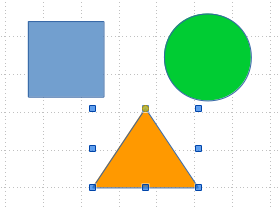Grouping and Combining Multiple Objects
Grouping and Combining Multiple Objects
The grouping and combining of objects is essential to any drawing application. With grouping and combining you can quickly edit multiple shapes and create more complex drawings.
Grouping objects
Grouping of objects is similar to putting objects into a container. You can move the objects as a group and apply global changes to the objects within the group. A group can always be undone and the objects that make up the group can always be manipulated separately.
Temporary grouping
A temporary grouping is when several objects are selected. Any changes to object parameters that you carry out are applied to all of the objects within the temporary group. For example, you can rotate a temporary group of objects in its entirety.

To cancel a temporary grouping of objects, simply click outside of the selection handles displayed around the objects.
Grouping
To group objects together permanently:
- Select the objects by clicking on each object in turn while holding down the Shift key, or use the Select icon
 on the Drawing toolbar and draw a selection rectangle around the objects using the cursor.
on the Drawing toolbar and draw a selection rectangle around the objects using the cursor. - Right-click on the group and select Group from the context menu.

When objects are grouped, any editing operations carried out on that group are applied to all objects within the group. If you click on one object in the group, the whole group is selected.
Entering and exiting the group
The objects within group retain their properties while at the same time can be edited independently. However, in order to edit individual objects belonging to a group, it is necessary to first to Enter the group. In this mode, the grouping is temporarily disabled so that we can edit group objects separately.
To Enter a Group simply double click on any object within the group or use the corresponding context menu item.

Now the group is temporarily disabled and you can start editing objects inside the group.

To exit the group right click and select Exit group from the context menu.
Ungrouping
To undo or ungroup a group of objects:
- Place the mouse cursor anywhere on the group area
- Right-click and select the Ungroup command from the context menu.

Combining objects
The Combine function, combines two or more selected objects into a single shape. Unlike grouping, a combined object takes on the properties of the lowermost object in the stacking order. You can split apart combined objects, but the original object properties are lost. When you combine objects, the drawing elements are replaced by Bézier curves and holes appear where the objects overlap.

To combine two or more objects
- Select the objects you want to combine.
- Right-click on the selection and select Combine from the context menu.

At first glance, the results can seem rather surprising, but once you understand the rules governing combination in Draw, combining objects will become clearer.
Merge, subtract and intersect
After you have selected more than one object, the Merge, Subtract, and Intersect functions become available, allowing you to create a new object with a new shape. Shapes take on the properties of the lowermost object in the stacking order.
- Select two or more objects
- Right-click on the selected objects and select Shapes from the context menu or objects, go to Modify > Shapes on the main menu bar.

Merge
When you merge objects, a new object is created with a shape that follows the shape of the merged objects. The area fill of the merged object is determined by the area fill of the object that is at the rear of all the other objects.

Subtract
When you subtract objects, the objects at the front are subtracted from the object behind. This leaves a blank space that the subtracted objects occupied.

Intersect
When you intersect two objects, you get the area covered by both objects.
